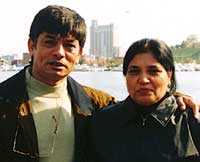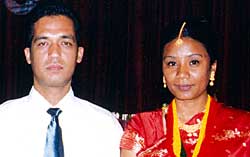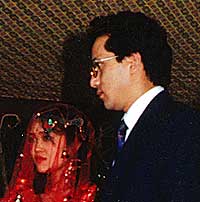 If the demographics of new Nepali couples these days is any indication, Nepal is well on its way to becoming an integrated society. King Prithbi Narayan Shah described the kingdom he united as a garden of many flowers. Well those flowers are getting cross-pollinated like never before.
If the demographics of new Nepali couples these days is any indication, Nepal is well on its way to becoming an integrated society. King Prithbi Narayan Shah described the kingdom he united as a garden of many flowers. Well those flowers are getting cross-pollinated like never before. Judging by an informal poll we carried out over the last marriage season, Nepali men and women are increasingly venturing beyond their caste-mates to find mates. And looking around Kathmandu it's not all that easy anymore to fit people into neat categories of caste and ethnic orientation based on facial features and accents anymore.
Today's intercultural couples are taking urban society by storm, even those that condone segregation. Two years ago when Monica Rizal, a Bahuni, married a Tamang, Chandan Lama, she recalls most people came to the marriage out of curiosity. "Things are changing. Now everybody is getting married intercaste. It's such an accepted part of society in the city," Monica muses. The Rizal and Lama households have readily accepted their children's choice. Luckily, Monica's family was not strictly Brahmin and Chandan's own mother is a Bahuni and father Tamang, so there was precedence for inter-ethnic wedlock.
 Monica and Chandan are well aware of the tolerance and leniency that urban life affords them. "I know there are still strong social barriers especially in the villages. But Kathmandu is becoming a melting pot and I don't feel like we've broken any barriers except the conditioning that society has imposed on us since childhood," says Chandan.
Monica and Chandan are well aware of the tolerance and leniency that urban life affords them. "I know there are still strong social barriers especially in the villages. But Kathmandu is becoming a melting pot and I don't feel like we've broken any barriers except the conditioning that society has imposed on us since childhood," says Chandan. Couples whose parents had mixed marriages feel it's easier to go through with it themselves for a variety of reasons, but at the core, it's family support that make all things possible. Just ask Sheri and Satendra Thapa. Sheri's father is Nigerian, her mother a Magar and her brother is married to a Sherpa. After they tied the knot, Satendra's family did not demand the couple stay with them.
Recalls Satendra: "Growing up in Dehradun, I didn't know about caste. Maybe because we were a minority, no one needed to know my father's jath or thar. I married a Nepali and that\'s it. It's ridiculous-people have gone to the moon and come back and we're still stuck on the jath thing."
 The concept of saving, keeping and maintaining 'face' is integral to Nepal's collectivist social structure, and personal life is gossip for the neighbourhood. Villages are less tolerant of those who don't live by the rules (see box, p9). In the order of things, almost all traditionalists view inter-racial marriages as even more galling than inter-caste unions but that's precisely what's happening as more Nepalis travel and live abroad.
The concept of saving, keeping and maintaining 'face' is integral to Nepal's collectivist social structure, and personal life is gossip for the neighbourhood. Villages are less tolerant of those who don't live by the rules (see box, p9). In the order of things, almost all traditionalists view inter-racial marriages as even more galling than inter-caste unions but that's precisely what's happening as more Nepalis travel and live abroad. Kala and George Varughese think of their union as complementing each other. Kala is the daughter of a Gurung soldier in the British army, born and raised in Brunei. George's parents are Keralan Christians and educators. The only prerequisite they had regarding George's wedding was that it be a Christian ceremony. In fluent Nepali, George says, "Nepalis are surprised I am married to a Nepali, but I was born in Gorkha and brought up in Nepal, so when I explain it to them, they are impressed."
 For Kala and George, the greatest obstacle hasn't been society-it is government bureaucracy. Their Christian wedding led to 10 months in and out of government offices for a marriage certificate. With Kala in the final trimester of her pregnancy, they have to face another unpleasant reality: "My children won't be eligible for Nepali citizenship regardless of how much we contribute to Nepal because my child's father is a foreigner."
For Kala and George, the greatest obstacle hasn't been society-it is government bureaucracy. Their Christian wedding led to 10 months in and out of government offices for a marriage certificate. With Kala in the final trimester of her pregnancy, they have to face another unpleasant reality: "My children won't be eligible for Nepali citizenship regardless of how much we contribute to Nepal because my child's father is a foreigner." Chandra Gurung had his family's support and belongs to a culture that not only accepted his Japanese wife, Tokiko Sato, but immediately made her feel completely comfortable. During their small wedding ceremony in Chandra's home village of Siklis in Lamjung, Tokiko wore traditional Gurung garb and family and friends came to celebrate their union. When Chandra went to visit Tokiko's family in Japan, he found them very similar to the Gurungs.
Later, Chandra challenged the traditional role of the father in Japan where he was a 'househusband'. "I would be so tired when my wife got home, but I enjoyed it," he recalls. "In any marriage give and take is important, and maybe more so in an inter-racial marriage."
Compromise is something Subarna Rai understands. Her husband Rajendra Rai is Catholic. A Catholic priest officiated their wedding ceremony in 1992, in which Subarna chose to wear a red sari, sindur and pote, in keeping with her Newari roots. Her in-laws came to ask for her hand in marriage for Rajendra, afraid the couple would elope, and her family accepted with no problems. "My family is nuclear, independent and very liberal," says Subarna. Though Subarna did not convert to Christianity, their son was baptised.
One half of Nepal's favourite comic duo, Madankrishna Shrestha met his better half Yashoda at work. She was a Bahuni and he a Newari. They were worried their families would not accept their union so they had small ceremony at Suryabinayak with just friends present. It took two weeks for their parents to come around which was followed by a traditional wedding with all the trimmings. "My father was understanding," recalls Mandankrishna. Inter-caste marriage was the focus of Madankrishna and Haribangsha Acharya's telefilm Pandhra Gate. "My children know people are all the same, which is a very important attitude in today's world," says Madankrishna.
Then there was another famous couple: he a PhD in architecture and she a lecturer at Pulchok Engineering Campus. She came from an affluent Newari clan, he from a landed Bahun family in Gorkha. Later, he joined politics and she became a social activist. Hisila Yami and Baburam Bhattarai have a daughter: Manavi Yami Bhattarai. They live underground, but not because of their inter-ethnic marriage.


